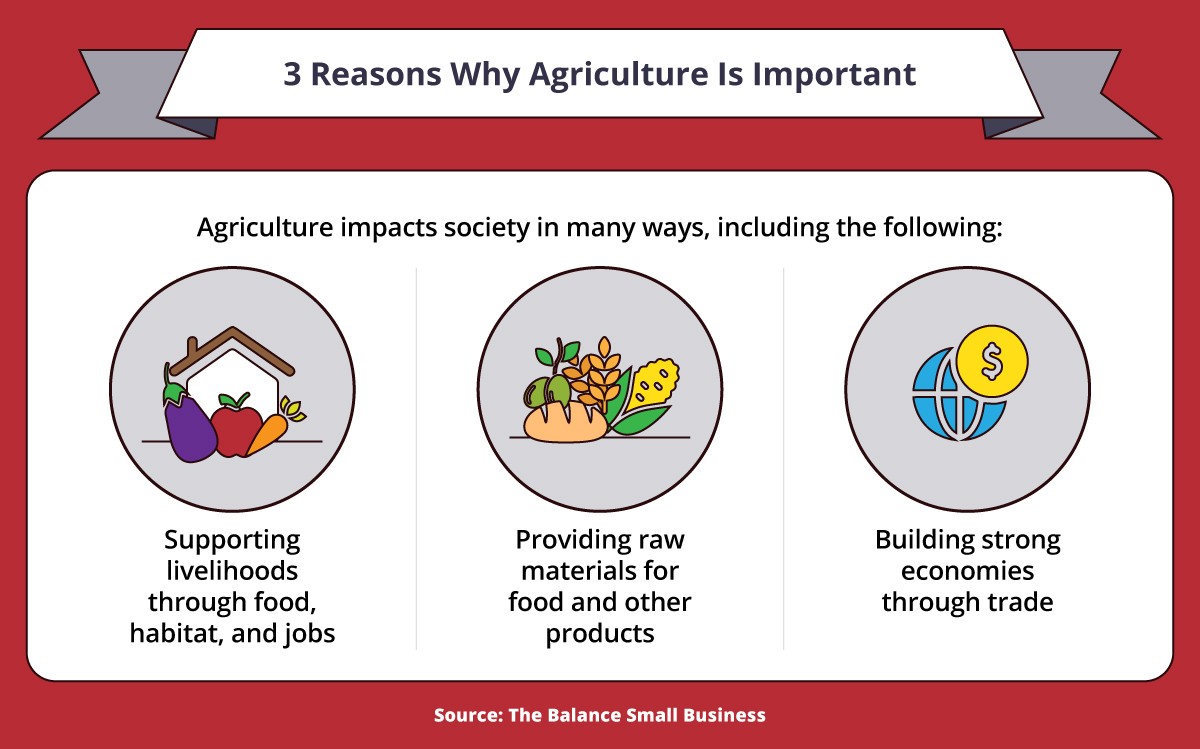When considering agriculture, many people immediately picture fields of crops: the process of preparing the soil, planting seeds, and then nurturing growth through fertilization, irrigation, and finally, harvesting. While crop farming is undoubtedly a significant part of agriculture, it’s just one piece of a much larger and more diverse sector.
According to the North American Industry Classification System (NAICS) defined by the U.S. Census Bureau, agriculture extends far beyond just growing plants. It encompasses a wide range of activities, including livestock farming, forestry, fishing, hunting, and crucial support services like agricultural equipment maintenance and transportation.
So, Why Is Agriculture Important? At its core, agriculture is fundamental to human survival. It provides the food we eat every day, sustaining life itself. Beyond sustenance, agriculture is also a major economic force, contributing a staggering $7 trillion to the U.S. economy alone. Despite its immense value, it’s important to acknowledge that, as the Economic Policy Institute points out, farmworkers often remain among the lowest-paid laborers.
However, agriculture also presents pathways to economic empowerment and prosperity for individuals and communities globally. Sub-Saharan Africa, for instance, has witnessed remarkable agricultural growth since 2000, exceeding any other region worldwide with an annual growth rate of approximately 4.3%, as reported by the United States Agency for International Development (USAID). This growth has significantly boosted the region’s overall economic progress. While global agricultural employment has seen a decline, from 1 billion in 2000 to 883 million in 2019, data from the Food and Agriculture Organization of the United Nations indicates that agriculture still stands as the second-largest employment sector globally, accounting for 26.7% of total employment.
Defining Agriculture: More Than Just Farming
Agriculture is best understood as the practice of cultivating natural resources to sustain human life and drive economic progress. It’s a dynamic field that blends the traditional skills of crop cultivation and animal husbandry with modern production techniques and technological advancements. Agriculture is not static; it constantly evolves, integrating innovation to meet the ever-growing demands of a global population.
Furthermore, agriculture functions as a critical business within the global economy, producing essential commodities. These commodities are basic goods used in commerce, ranging from grains and livestock to dairy products, fibers, and raw materials for fuel. Fiber, for example, is a leading agricultural product in the U.S., according to The Balance Small Business, and a vital commodity for the vast clothing industry.
The Multifaceted Importance of Agriculture
Agriculture’s importance to both business and society stems from its vast output. It’s the foundation of numerous industries, from the production of basic raw materials to its crucial role in the global supply chain and overall economic development. Let’s delve deeper into these key aspects:
Supplying Essential Raw Materials
Raw materials are the fundamental building blocks of the global economy. Without consistent access to these materials, manufacturing industries would grind to a halt. While some raw materials are non-agricultural, such as steel and minerals, a significant portion originates directly from agriculture. This includes everything from lumber for construction to herbs that enhance the flavors of our food.
Consider corn, a versatile agricultural product. It’s not only a staple food source but also a key ingredient in ethanol production, a type of biofuel. Another example is resins, plant-based substances used extensively in industrial applications. Resins are crucial in the production of adhesives, protective coatings, and even paints used in the construction industry. Agriculture, therefore, is the wellspring of countless raw materials that underpin diverse sectors.
Building Resilient Supply Chains
The global economy relies on intricate supply chains to move goods across borders. Agriculture is a central player in this system, as the import and export of agricultural products necessitate complex shipping networks involving ocean freight, railways, and trucking. Disruptions in one part of this chain can have ripple effects worldwide. For instance, delays in agricultural shipments at a port in Los Angeles can create bottlenecks in China, and vice versa, impacting the entire global supply chain.
The Iowa Soybean Association highlighted this interconnectedness when soybean crop exports from Iowa surged in 2021. This surge was partly due to shipment delays from South America, creating an opportunity for Iowa’s agricultural sector. This example showcases how disruptions can create advantages for some, but it also underscores the potential for widespread negative consequences. Shipping delays can limit product availability, impacting businesses and livelihoods across regions reliant on those agricultural imports.
Driving Economic Growth and Development
Agriculture’s impact extends far beyond just food production; it’s deeply intertwined with other economic sectors, acting as a catalyst for job creation and broader economic development. USAID data indicates that countries with thriving agricultural sectors tend to experience employment growth in other parts of their economies. Furthermore, nations that achieve agricultural productivity growth and invest in robust agricultural infrastructure typically see higher per capita incomes. This is because increased productivity, often driven by technological innovation and advanced farm management practices, boosts profitability within the agricultural sector and beyond.
Essential Resources on Agricultural Importance
To further explore the multifaceted importance of agriculture, particularly as a source of raw materials, its impact on transportation networks, and its significant contribution to economic development, consider these valuable resources:
The Pervasive Influence of Agriculture: Beyond the Plate
While disruptions in technology supply chains, like shortages of computer chips, often grab headlines, it’s crucial to remember that agriculture is equally vital in meeting the demands of consumers and businesses in our interconnected world. Agriculture provides a vast array of products that are fundamental to our daily lives and industries.
Nourishing Diets with Fruits and Vegetables
Fruits and vegetables are cornerstones of human nutrition, delivering essential fiber, vitamins, proteins, and carbohydrates. They are rich sources of vital nutrients like vitamins A, C, and E, and minerals such as magnesium, zinc, and phosphorus. Beyond their health benefits, fruits and vegetables add diversity and flavor to our diets, making meals enjoyable and culturally rich.
Sustaining Livestock with Animal Feed
A significant portion of agricultural output is dedicated to animal feed, supporting livestock and poultry farming. The American Feed Industry Association notes that approximately 900 animal feed ingredients are legally approved in the U.S. These ingredients are largely derived from agricultural production, including hay, straw, oils, sprouted grains, and legumes, ensuring the health and productivity of livestock.
Enabling Mobility with Natural Rubber
With over 1.4 billion vehicles operating worldwide, as estimated by Hedges & Company market research, the demand for rubber is immense. Every vehicle relies on rubber tires, highlighting the critical role of natural rubber production. GEP reports that Thailand, Indonesia, and Malaysia are the top rubber-producing nations, collectively accounting for about 70% of global natural rubber production. Remarkably, around 90% of rubber suppliers are small-scale farmers, demonstrating the importance of this sector to livelihoods in these regions.
Clothing the World with Cotton
The journey of cotton, from field to fabric, begins with agricultural production. Cotton is cultivated, harvested, processed, spun, and woven into fabric before becoming the clothes we wear. Forum for the Future highlights cotton as a leading global commodity, comprising approximately 31% of all textile fibers worldwide. The cotton industry represents a vast global supply chain, impacting economies and livelihoods across continents.
Powering Industries with Biofuels
The U.S. Environmental Protection Agency (EPA) emphasizes the economic advantages of biofuels, which are produced from biomass sources like corn, soybeans, sugarcane, and algae. Biofuels offer several benefits, including reducing greenhouse gas emissions and air pollutants, and creating potential income streams for farmers. While biofuel production requires land and water resources, which can influence food costs, it represents a significant stride towards sustainable energy.
Fueling Innovation with Industrial Products
Bio-based chemistry leverages raw materials derived from biomass to create a wide range of industrial products. These bio-based products include bioplastics, plant oils, biolubricants, inks, dyes, detergents, and fertilizers. Bio-based chemicals and products offer environmentally friendlier alternatives to conventional petroleum-based products, promoting greener industrial practices and reducing environmental impact.
Healing and Wellness through Pharmaceuticals
For millennia, plants have been a source of medicinal compounds. Ginger, for example, is known for its digestive benefits. The foxglove plant yields chemicals used to produce digoxin, a crucial drug for treating heart failure. Polylactic acid (PLA), derived from fermented glucose in green plants, has diverse applications in tissue engineering, cardiovascular implants, cancer therapy, and surgical implant fabrication, as detailed in a study published in Engineered Regeneration. Agriculture, therefore, plays a vital role in pharmaceutical advancements and healthcare solutions.
Agriculture’s Indispensable Role in Everyday Life
Agriculture’s influence permeates our daily routines in countless ways. Prior to the advent of agriculture, human survival depended on hunting and gathering. The shift to systematic crop cultivation and harvesting marked a turning point, enabling human populations to flourish. This transition spurred the development of tools and practices that enhanced agricultural productivity, leading to societal advancements and the rise of modern industries.
Today, the importance of agriculture in everyday life cannot be overstated. Many of our daily activities, from getting ready in the morning to maintaining our homes, are made possible by agricultural products. Consider these examples:
- Shelter: Wood and plant-based materials like bamboo are essential for construction and interior décor, providing the materials for our homes and buildings.
- Morning Routine: Mint in toothpaste provides flavor and oral hygiene benefits, while the caffeine in our morning coffee, derived from coffee beans, provides an energy boost to start the day.
- Dressing Up: Beyond cotton, clothing is also made from hemp, flax, and ramie. Bio-based materials are used in grooming products such as skin creams and shampoos, contributing to personal care.
- Cleaning: Surfactants and solvents, key components in detergents, cleaning products, and soaps, can be derived from biomass, highlighting agriculture’s role in household hygiene.
- Driving to Work: Rubber from rubber trees is essential for tires, and biodiesel fuel, often containing ethanol from corn, powers vehicles, enabling transportation and commuting.
- Entertainment: Paper, derived from trees, is fundamental for writing and printing, while musical instruments like reed instruments rely on plant-based materials for their construction and sound production.
- Education: From wooden pencils to paper textbooks, students depend on agricultural products for essential learning tools every day.
The Economic Powerhouse: How Agriculture Fuels Economies
Agriculture exerts a substantial influence on the economy. The U.S. Department of Agriculture (USDA) Economic Research Service reports that in 2020, the agricultural and food sectors accounted for 10% of all U.S. employment, providing nearly 20 million full- and part-time jobs. Furthermore, the USDA reported nearly $198 billion in cash receipts from crops and $165 billion from animal and animal products in 2020.
The Cybersecurity and Infrastructure Security Agency (CISA) emphasizes the interdependence of the food and agriculture sector with critical infrastructure sectors like water and wastewater systems, transportation, energy, and chemicals. This interconnectedness underscores agriculture’s role as a vital engine for broader economic activity.
Agriculture contributes to the U.S. Gross Domestic Product (GDP) both directly and indirectly, through diverse activities including farm production, forestry, fishing, textile manufacturing, apparel, food and beverage sales, service industries, and manufacturing.
- Farm Production: USDA data reveals that in 2020, the U.S. had over 2 million farms spanning 897 million acres. Farm production encompasses the cultivation of fruits, vegetables, and various crops to meet domestic and international demand.
- Forestry and Fishing Activities: Agriculture extends to forestry, focused on sustainable forest management, and fishing, including aquaculture, which involves controlled fish and seafood production.
- Textile Mills and Products: The U.S. cotton industry alone generates $21 billion annually, creating jobs for growers, processors, and various stakeholders across the textile supply chain.
- Apparel and Food & Beverage Sales: Selling agricultural products is a crucial aspect of the sector. Food services and eating and drinking establishments accounted for 10.5 million jobs in 2020, representing the largest employment segment within the agriculture and food sectors.
- Manufacturing: Agricultural products are essential inputs for manufacturing a vast array of goods, including food and beverages, textiles, cleaning and personal care products, construction materials, and fuels. Food and beverage manufacturing companies employ approximately 1.7 million people in the U.S.
Here are additional ways agriculture and related industries drive economic development:
Agribusiness: The Commercial Engine
Agribusiness encompasses all commercial activities involved in bringing agricultural goods to market, from family farms to global conglomerates. In 2019, U.S. farms contributed about $136 billion to the GDP, approximately 0.6% of the total.
However, agribusiness extends beyond just farms. It includes businesses involved in manufacturing agricultural equipment, producing fertilizers and chemical products, and developing biofuels. Collectively, farms and related agribusiness industries contributed over $1.1 trillion to the GDP in 2019, slightly over 5% of the total.
The economics of agribusiness are crucial for maintaining economic and social stability. Agribusiness fosters innovation, technological advancements, and organizational knowledge, playing a vital role in environmental protection, biodiversity conservation, and sustainable resource management near farms.
Food Security: A Global Imperative
Food security is central to the agricultural industry. Sustainable agriculture is essential for achieving the United Nations’ Sustainable Development Goals (SDGs), particularly SDG 2: Zero Hunger. The World Bank highlights that agricultural sector growth is up to four times more effective in raising incomes among the poorest communities compared to other sectors, directly addressing poverty and hunger.
Job Creation: A Source of Livelihoods
Agriculture is a significant job creator worldwide. In developing countries in Latin America, agriculture accounts for 25% of exports and approximately 5% of the regional GDP, according to BBVA. In the U.S., agriculture and related industries provide 19.7 million jobs, representing 10.3% of total employment, demonstrating its crucial role in providing livelihoods and economic opportunities.
Further Resources on Agriculture’s Economic Impact
To delve deeper into the economic impact of agriculture, including its resilience to disruptions and its benefits to livelihoods, explore these resources:
Agricultural Biodiversity: Investing in a Resilient Future
While advanced farming techniques and increased use of fertilizers and pesticides have boosted crop yields, they have also raised environmental concerns, contributing to soil and water pollution and climate change. NASA projects a potential 24% decline in corn crop yields by 2030 due to climate change. However, promoting agricultural biodiversity can be a key strategy to mitigate these negative impacts.
Resources on Agricultural Biodiversity
To learn more about agricultural biodiversity and its importance, explore these resources:
Agriculture: A Cornerstone for a Sustainable Future
Agriculture is not only essential for our present needs but also holds the key to improving the lives of millions facing food insecurity and fostering economic development across nations. The choices we make in agriculture today will profoundly impact future generations. Building a more sustainable and equitable global agricultural system, aligned with the UN’s Sustainable Development Goals, is imperative to ensure a prosperous and just future for all.
Infographic Sources
American Farm Bureau Federation, “Farm Contribution to Agricultural GDP at Record Low”
Commodity.com, “Learn All About Agricultural Commodities and Market Trends”
Environmental Protection Agency, Commonly Consumed Food Commodities
The Balance Small Business, “What Is Agricultural Production?”
ThoughtCo, “List of Medicines Made From Plants”
USDA, Ag and Food Sectors and the Economy
USDA National Agricultural Library, Industrial, Energy, and Non-food Crops


